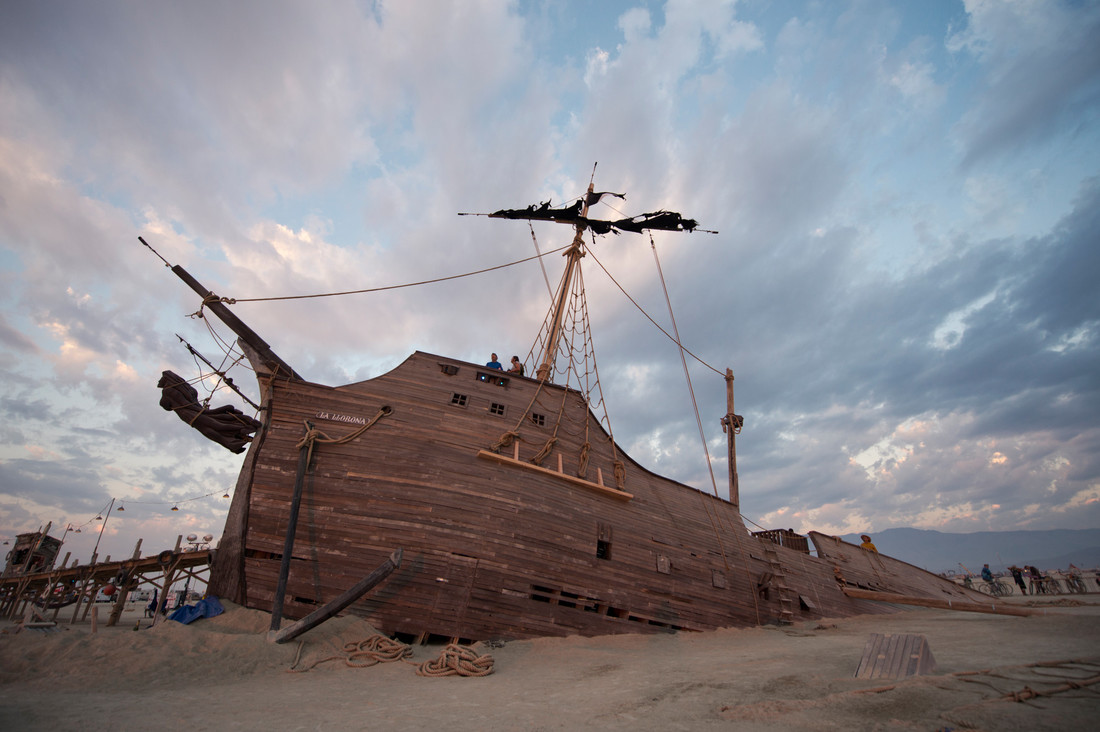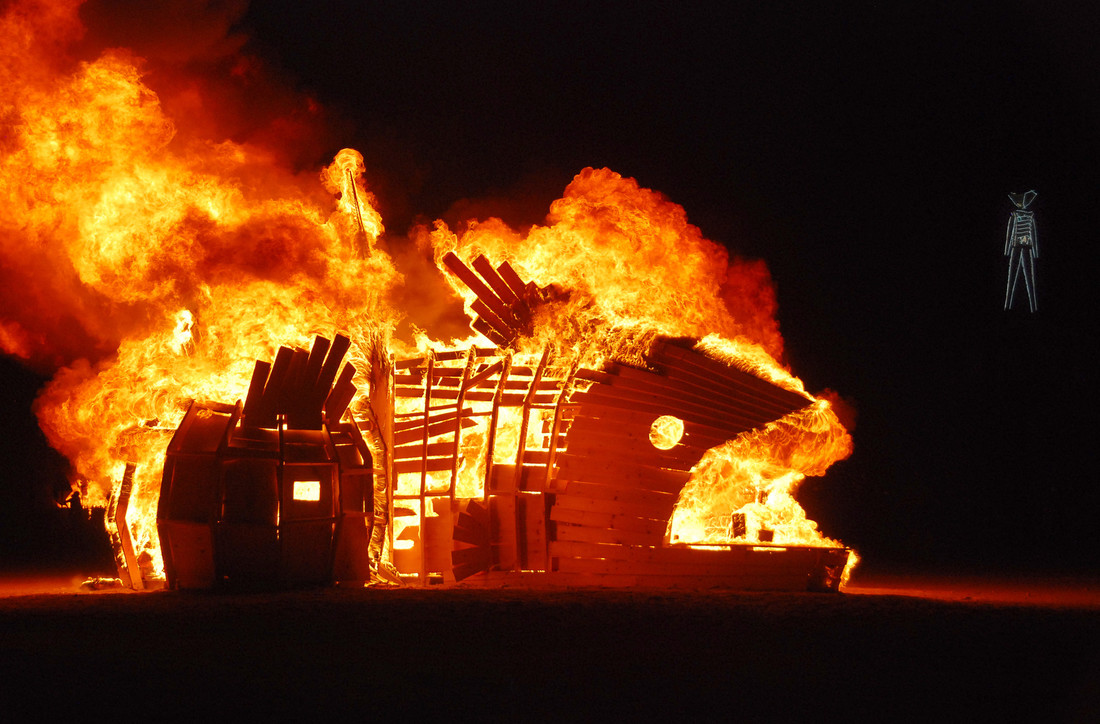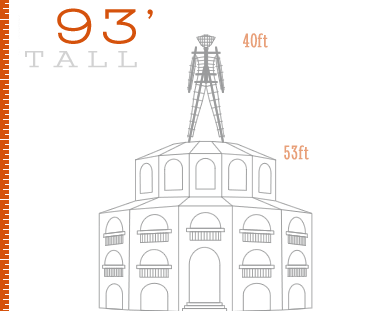
- The beautiful honeycomb design of the Pavilion was the last structure conceived by Rod Garrett, our beloved and belated City Designer.
- Constructed to evoke the form of a beehive, the Man Pavilion acted as a hive of activity at the heart of our city.
- With three floors and a climbable Pistil in the center, the Man Pavilion was awe-inspiring space that could hold up to a thousand participants at a time.
- The exterior walls of the structure were painted in such a way as to reflect the environment surrounding us.
- The Man Body was white neon with honey colored face and honey yellow outlines on side, arms, legs and in the ornament.
- Choreographed lighting basked the inner buttresses and alcoves in ever-changing shades of blue, green, pink and more.
- Encircling the structure on the outside, the "Fertilibee Lights" AKA "The Cock Lights", designed by Jack Haye, Mike Hollibaugh, Julie Young, Claus Brigmann, and Jiri Jacknowitz, expressed the 2012 theme of Fertility 2.0 in a humorous manner, while also providing a resting spot for those who wanted to just enjoy the view of the Pavilion.
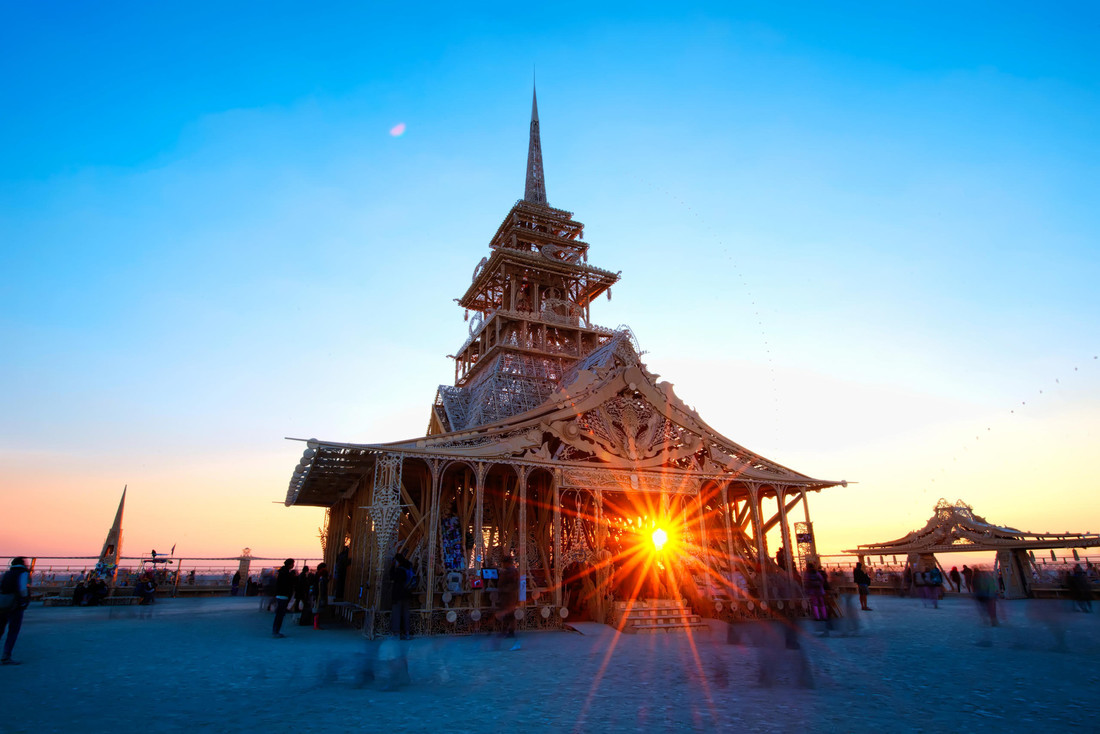
The Temple
The force that through the green fuse drives the flower
Drives my green age; that blasts the roots of trees
Is my destroyer.
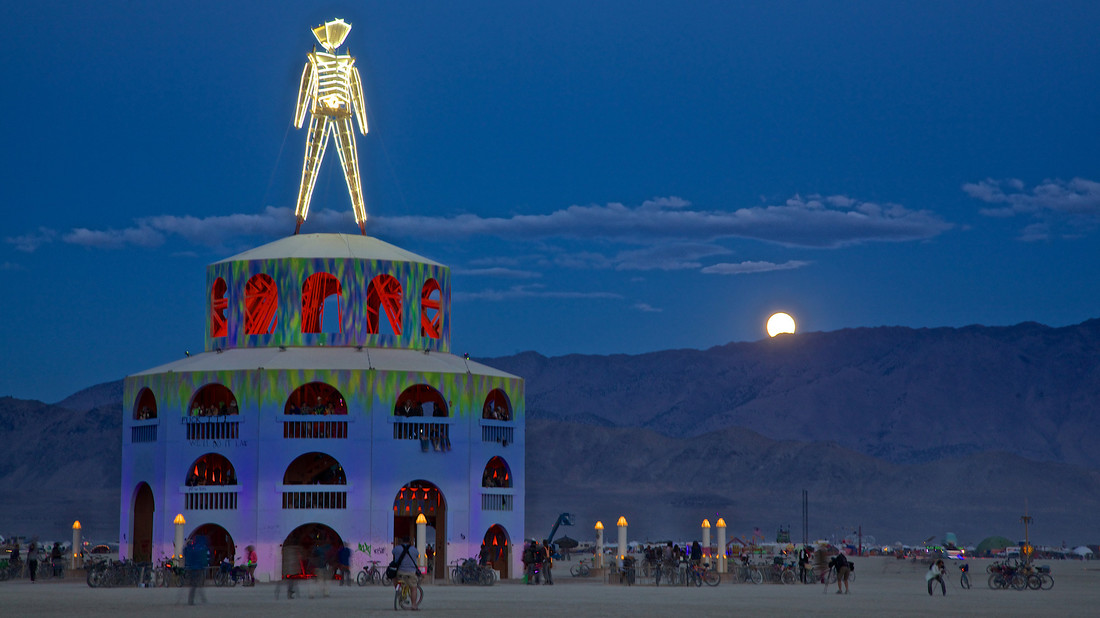
Black Rock City is a kind of Petri dish. Theme camps cling in fertile clusters to its latticework of streets, artworks tumble out of it, like pollen on the air. These nodes of interaction mutate, grow and reproduce their kind. Burning Man communities have now escaped this capsule world: our culture in a Petri dish has effloresced - it spreads across five continents. This year's art theme contemplates the tendency of any being or living system to create abundant life.... We are living in an age of mass production and consumption that is unsustainable. But culture, as a living system, has the power to create and recreate itself. It thrives as a result of numberless and unplanned interactions. All that's really needed is a fitting social vessel to sustain it. The founders of our city now propose to seek out new environmental contexts where our ethos can take root. Theme: Fertility 2.0
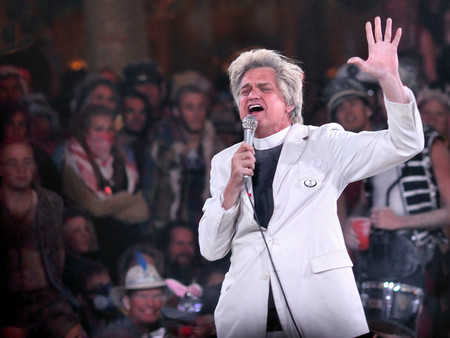
Rev Billy in Center Camp Cafe. Photo Steven Fritz
- Speaker Series Theme: Occupy the Imagination
- Operafication (suspension with Opera Singer) with Dustin & Matthew Setzer
- FreeBass BK
- Jug:Step
- Razaman
- Center Camp Cafe IGNITE Talks
- Diva Marisa
- March Fourth Marching Band
- Burning Opera
- Yogoman Burning Band
Within the Burning Man organization and throughout the community, one word was said far more than any other in 2012: tickets. After Burning Man tickets sold out for the first time ever in 2011.
Burning Man organizers responded to the anticipated demand for the 2012 event with a new ticketing plan designed to level the playing field for buyers… The random selection process that was instituted ultimately created some serious unintended consequences. Namely, the fact that theme camps, art teams, mutant vehicle crews and infrastructural volunteers found that sizable portions of their key members were left without tickets.
Burning Man staffers worked hard to understand the situation as quickly as possible, and devised solutions once the nature of the problems came to light, taking necessary measures to ensure the stability of the core infrastructure of Black Rock City — always working with an eye towards what would best serve the most members of our community. The ticket situation impacted every department in the Burning Man organization but each stepped up in a big way to deal with the fallout.
On the playa, a record number of art installations were created by participants for Black Rock City — over 360 incredible pieces graced the open spaces inside the city’s perimeter, 44 of which were honoraria funded in part by $700,000 in art grants sourced from ticket revenues. 34 of these projects were part of the Circle of Regional Effigies (CORE), created by teams drawn from Burning Man’s Regional Network, placed around the Man, and burned simultaneously on Thursday night of the event — creating what just might well have been the largest coordinated simultaneous burn anywhere, ever.
Returning artists included Kate Raudenbush (“Star Seed”), the Flux Foundation (“Zoa”), Matt Schultz (“Pier 2”), Dadara (“Transformoney Tree”), Zach Coffin (“The Universe Revolves Around YOU”), Laura Kimpton and Mike Garlington (“EGO”), and Otto von Danger (“Occupy Wall Street”), to name a few.
The new Burning Man Project non-profit started the hard work of developing the administrative and operational infrastructure needed to get their ambitious mission under full steam and this year, the Man stood atop the Pavilion, the last — and perhaps most spectacular — structure ever designed by Burning Man’s long-time city designer and architect Rod Garrett. Rod passed away just before the 2011 event, and his legacy will be felt by every person who ever has the opportunity to experience Black Rock City. His vision, talent and creativity are very much missed in the Burning Man organization.
Read more

- The Burning Man event sold out tickets for the second year in a row.
- The Burning Man organization instituted a new ticketing strategy, including a random selection system to determine who gets tickets. Many Burners core to the creation of the infrastructure of Black Rock City were left without tickets, and the organizers worked through the spring and summer to resolve the problems, including a Direct Distributed Tickets program to ensure tickets got to teams creating key theme camps, art installations, mutant vehicles and department volunteers.
- Burning Man created the Secure Ticket Exchange Program (STEP), facilitating the safe and hassle-free exchange of tickets between Burners in the aftermarket.
- Burning Man technology team built SPARK, an online system designed to facilitate the creation of teams for collaborative projects.
- A larger-than-usual number of first-time Burners came to Black Rock City, making up approximately 35% of the population.
- One of the dustiest years ever for Black Rock City, with anemic winter rains making for an exceptionally dusty playa surface.
- Black Rock City streets named after species of flowers, from Alyssum to Lilac. The road circling Center Camp is named "Rod's Road" in honor of BRC designer Rod Garrett (1936-2011).
- 978 theme camps were approved for pre-placement in Black Rock City. 53 total camps were denied placement.
- 360 pre-registered art projects graced the playa, including 44 honoraria projects funded in part by $700,000 in art grants sourced from Burning Man ticket revenues.
- 34 art projects were part of the Circle of Regional Effigies (CORE), created by teams drawn from Burning Man's Regional Network, placed around the Man, and burned simultaneously on Thursday night of the event.
- David Best and his crew created the Temple of Juno, in a traditional Balinese temple structure, including a fenced courtyard, a towering spire, and a massive central chandelier.
- Ingress traffic into the city, and exodus out were largely a non-issue as participants heeded warnings to arrive and depart at off-peak times, and Gate crews revamped their systems.
- The Department of Mutant Vehicles received more applications than ever, and does not increase the total number of vehicles licensed, due to on-playa safety concerns.
- When the Man burned in Black Rock City on Saturday night, the conflagration created what was by far the hottest Man burn to date.
- Playa restoration crews grew to their largest size yet, reacting to the increase in BRC population. Black Rock City passed BLM inspection with flying colors.
- Burning Man's waste and recycling crew diverted more recyclables in 2012 than any other year.
- The Reno/Sparks Drive-Thru Recycling Project returned in 2012 with a new name: EXTRA (Exodus Trash and Recyling Program). Overseen by Burners, and now expanded to Cedarville, EXTRA collected trash 24 hours a day during Exodus week.
- Prior to the 2012 event, Burning Man filed suit against Pershing County over drastic fee increases.
- The Bureau of Land Management (BLM) produced a public document called the 2012-2016 Burning Man Environmental Assessment (EA), outlining what needs to be done to protect the playa and surrounding communities. Burning Man created communications campaigns to increase participant awareness of these issues.
- Over 30 new Regional Contacts were added from locations across the world including Singapore, Spain, and South Africa. Interest from international groups continued to grow as Burners from Russia, Austria, the Yucatan, Brazil, Columbia, Chile, South Korea, Israel, Malaysia, and Vietnam have expressed interest in representing Burning Man in their home countries.
- Black Rock City LLC, The Burning Man Project, Black Rock Arts Foundation and Black Rock Solar settled in to the second year in their mid-Market corridor San Francisco headquarters.
- The new Burning Man Project non-profit started developing the administrative and functional infrastructure needed to get their ambitious mission under full steam, including developing program initiatives in the arts, civic involvement, social enterprise, education and more.
Change has come to Burning Man … again … and we can't prevent it. (And would we if we could?) But we can use it as an opportunity to be better than we are.
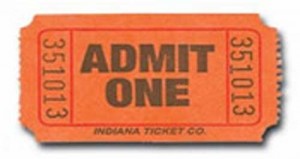
I’m sure you’ve heard, some people are pretty sure that this, finally, is the end of Burning Man. The Man is dead! Long live Burning Man!
...but I’m convinced that the fact that we argue so passionately about Burning Man pretty much shows how much we care about it.








































